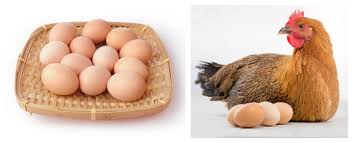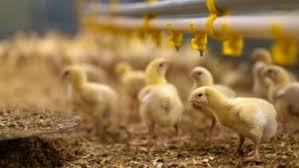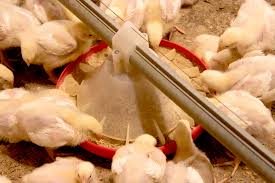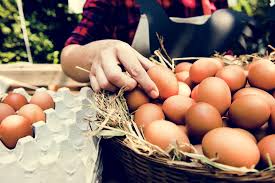Farmers house and feed chickens carefully to maximize egg-laying and ensure the hens have a long and healthy life. Egg producers maintain flocks of hens at different ages, ensuring a steady supply of eggs for the market, providing year-round income.
The females (mature hens and younger pullets) are raised for both meat and egg production, and breeds have been developed to fulfill commercial needs. While fresh egg production is primary to the egg industry, a significant amount of egg production involves eggs purposely broken and used for powdered eggs, frozen eggs, or purchased by food producers for inclusion in food products.
The broiler growing phase is only one part of the integrated total meat production process. The objective of broiler management is to achieve the required flock performance in terms of bird welfare, live weight, feed conversion, uniformity, and meat yield within economic constraints.
Broiler production is a sequential process, with ultimate performance dependent on the successful completion of each step. For maximum performance, each stage must be critically assessed, and improvements made where necessary.
Read Also: 12 Medicinal Health Benefits Of Betula lenta (Sweet birch)
Egg Production Cycle: Phases for Layers

Birds usually start to lay around five months (20-21 weeks) of age and continue to lay for 12 months (52 weeks) on average, laying fewer eggs as they near the moulting period. The typical production cycle lasts about 17 months (72 weeks) and involves three distinct phases:
Phase 1: Small Chicks or Brooders (0-8 Weeks)
This phase lasts from 0 to 2 months (0-8 weeks) during which small chicks are kept in brooder houses, separate from laying birds.
Phase 2: Growers (9-20 Weeks)
This phase lasts about 3 months, from the ninth to the twentieth week of age. Growers may either be housed separately from small chicks or continue to be reared in brooder-cum-grower houses. Special care should be provided to the growers particularly between the seventeenth and twentieth week of age as their reproductive organs develop during this period.
Phase 3: Layers (18-72 Weeks)
Growers are transferred from the grower house to the layer house when they are 18 weeks old to prepare for the laying cycle. Birds typically lay for a twelve-month period starting when they are about 21 weeks old and lasting until they are about 72 weeks old.
Management of Chicks: Key Preparations Before Arrival

Before chicks arrive at home, make sure that:
i. A brooder is in place.
ii. Paraffin lamps, electric bulbs, or charcoal stove are available.
iii. Litter for the floor is available (1m² will accommodate 20 chicks up to 4 weeks old).
Iv. Temperature Control: Maintain 35°C for day-old chicks, reducing to 24-27°C after one week. Gradually reduce the heat as they grow, especially at night.
Feeding Exotic Chickens: Broilers and Layers
1. Broilers: For 1 to 3 weeks, feed with chick mash. From 3 to 6 weeks, switch to broiler starter, and after 6 weeks, feed with broiler finisher.
2. Layers: For 1 to 8 weeks, feed on chick mash. After 8 weeks, gradually introduce growers mash, then switch to layers mash after the first egg is laid.
Management of Layers for Maximum Egg Production
- Ensure good air circulation in the laying house.
- A layer needs about 120g of food per day on average.
- Distribute food and water troughs evenly (one basin per 50 birds).
- Provide grit at 20 weeks of age.
- Keep laying nests in dark places, and collect eggs three times a day. Allow one nest for every five hens.
- Use soft, clean litter, and store eggs with the small end down.
- Clean dirty eggs with steel wool or coarse leaves (never wash them).
- Add greens to the diet, and whenever possible, vitamins to the water.
- Debeak birds at the onset of lay.
- Cull birds when egg production drops below 40%.
Read Also: The Health Benefits of Using Mexican Seasoning on your Cooking
Setting the Stage Before Chicks Arrive

1. Brooder: A brooder is a safe place to keep chicks warm, watered, and fed. Many chick growers use a large plastic tote or a large cardboard box with high walls. A ventilated lid is necessary to prevent chicks from escaping as they grow bigger.
2. Brooder Location: The brooder should be placed in a warm, dry area. It can be set up in a garage, house, or even the chicken coop (if there are no adult chickens in the coop).
3. Heat Lamp: A heat lamp is essential for maintaining the right temperature for the chicks. Products specifically made for this purpose are safer and more consistent than regular lamps.
4. Thermometer: Although not absolutely crucial, a thermometer helps in monitoring the temperature in the brooder more easily.
5. Bedding: Pine shavings are ideal bedding material. For the first week, however, newspapers with a layer of paper towels on top are preferred to prevent chicks from eating the shavings.
6. Waterer and Feeder: Proper waterers and feeders designed for chicks are necessary. Improper systems can lead to chick mortality.
7. Chick Starter Feed: Use feed designed as starter feed for chicks during the first eight weeks.
8. Electrolyte Powder: For chicks arriving by mail, adding electrolyte powder to their water gives them extra strength during their early days.
First Week: Acclimating Chicks to Their Environment
- Maintain a brooder temperature of 90°F.
- Dip each chick’s beak in water to ensure they drink.
- Repeat the same procedure with feed.
- Keep feed and water on the outskirts of the heat lamp to prevent them from overheating.
- Chicks will sleep a lot during this first week.
Subsequent Weeks of Chick Care: Gradual Adjustments
Week 2: Lower brooder temperature to 85°F, switch bedding to pine shavings, and introduce a small amount of chick grit.
Week 3: Reduce brooder temperature to 80°F and add a lid to the brooder.
Week 4: Introduce the chicks to the pen for short periods.
Week 5: Stop using the heat lamp if night temperatures remain above the 60s.
Week 6: Move chicks from the brooder to the coop.
Week 8: Expand their diet with treats like lettuce.
Week 12: Prepare nesting boxes for hens.
Week 16: Place fake eggs in the nesting boxes to help hens learn.
Week 20: Start collecting eggs and maintaining nesting boxes for cleanliness.
Broiler Poultry Farming: Focus on Meat Production
Broiler poultry farming is a profitable business. Broilers are developed scientifically to produce more meat in a shorter time compared to other poultry birds. By following the procedures above, sustainable and profitable broiler production can be ensured.
Do you have any questions, suggestions, or contributions? If so, please feel free to use the comment box below to share your thoughts. We also encourage you to kindly share this information with others who might benefit from it. Since we can’t reach everyone at once, we truly appreciate your help in spreading the word. Thank you so much for your support and for sharing!
Frequently Asked Questions
We will update this section soon.

